
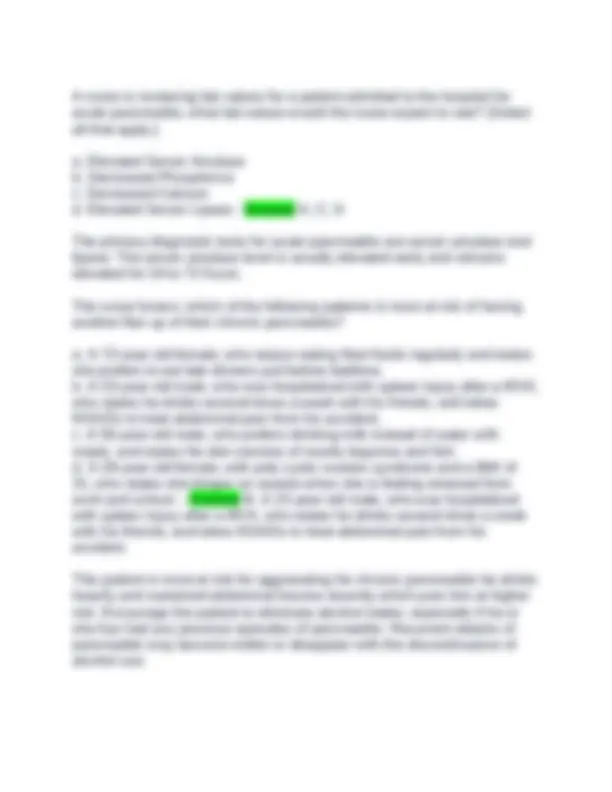
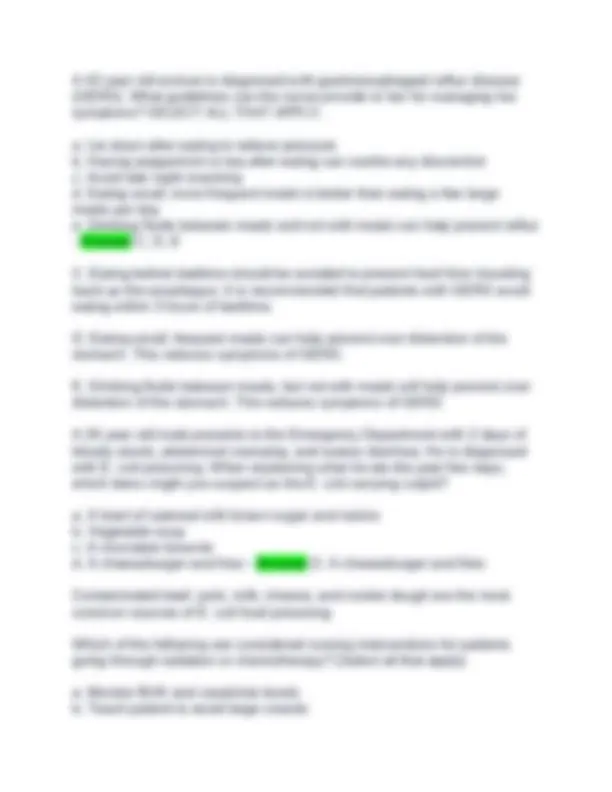
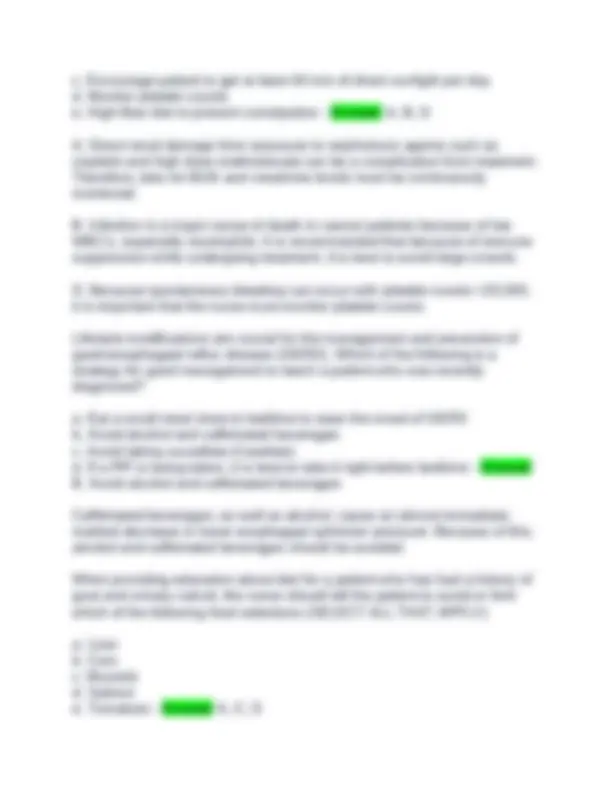
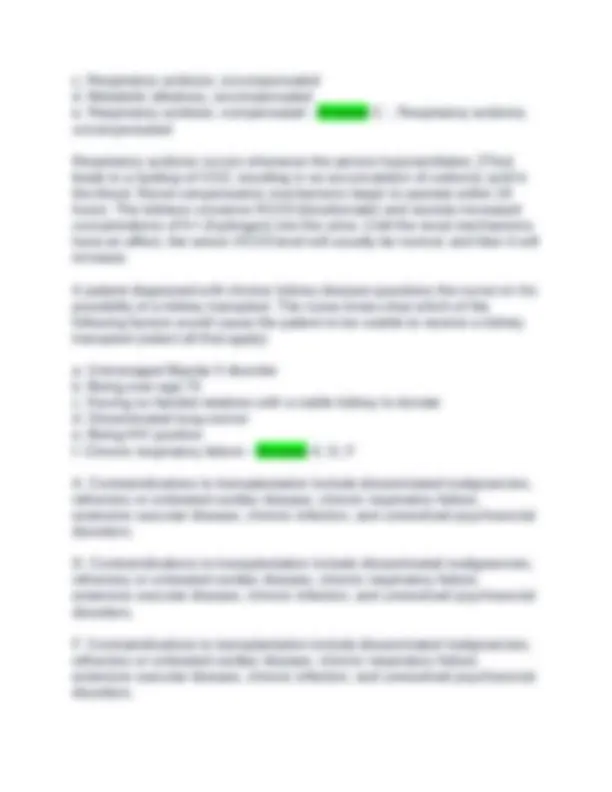
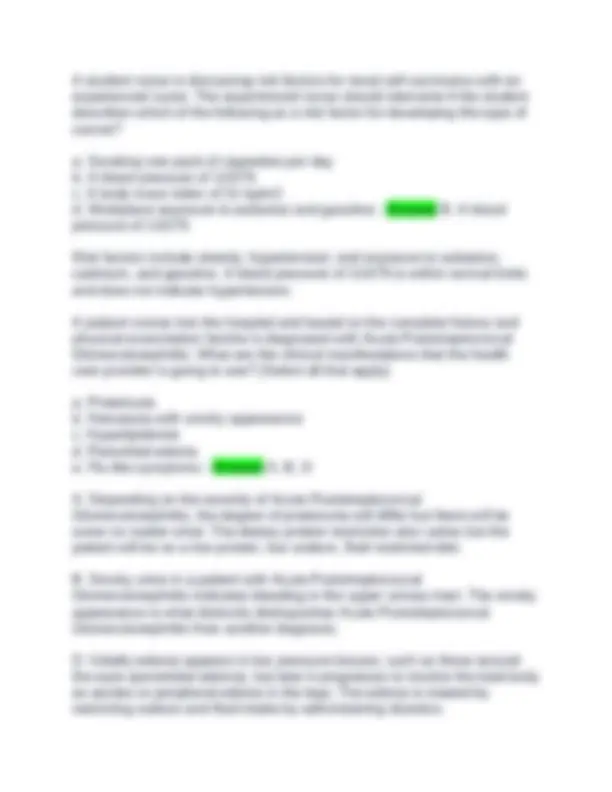
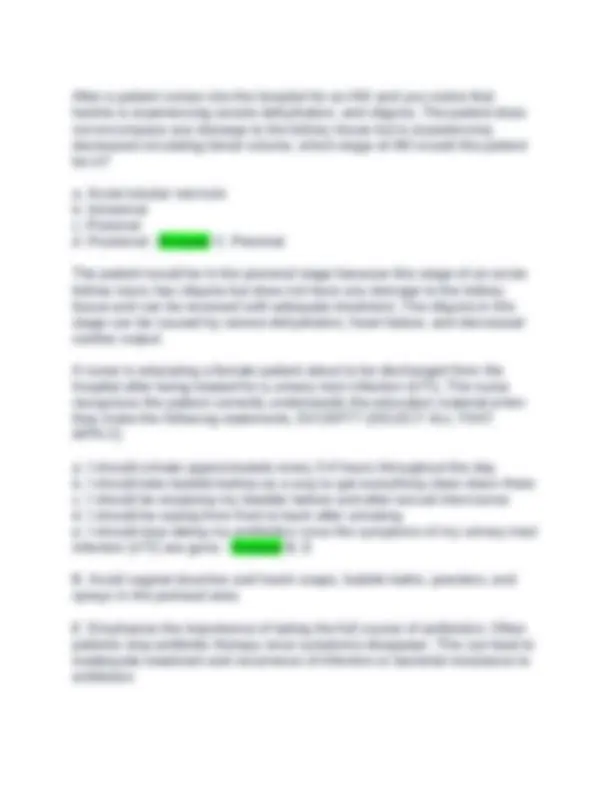
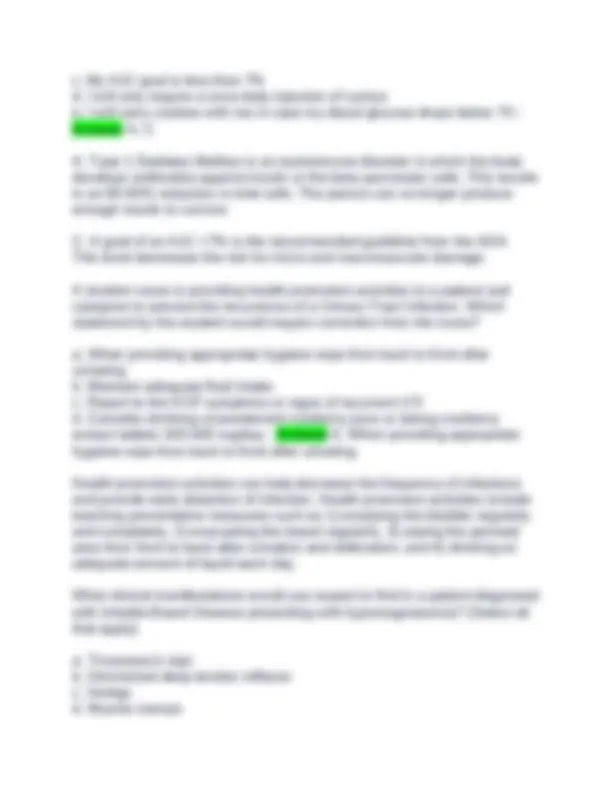
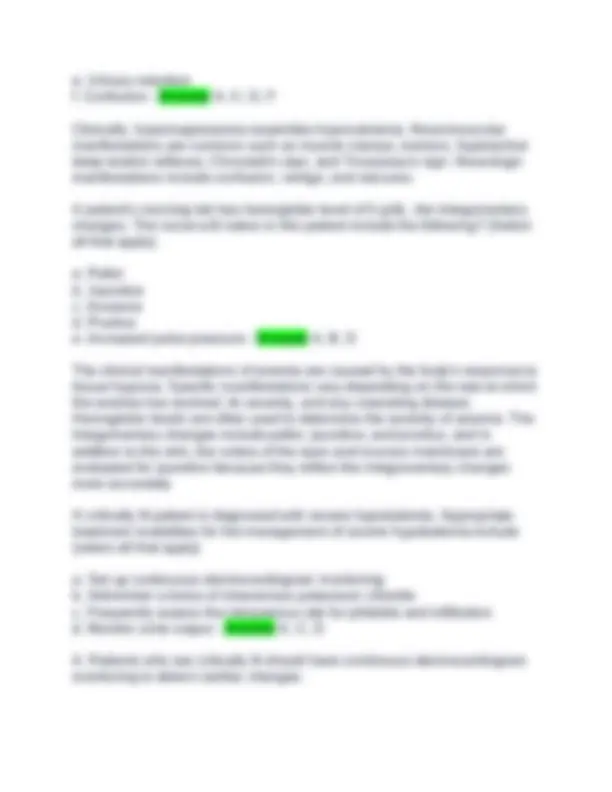
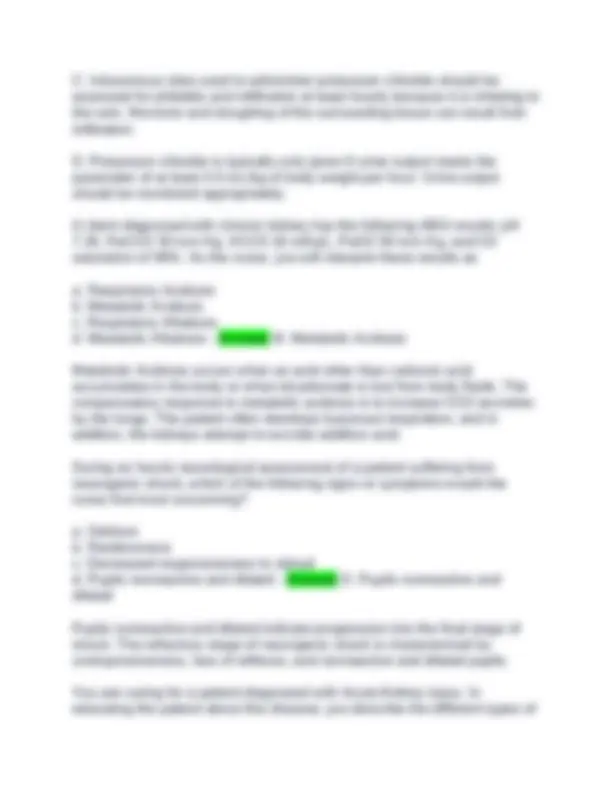
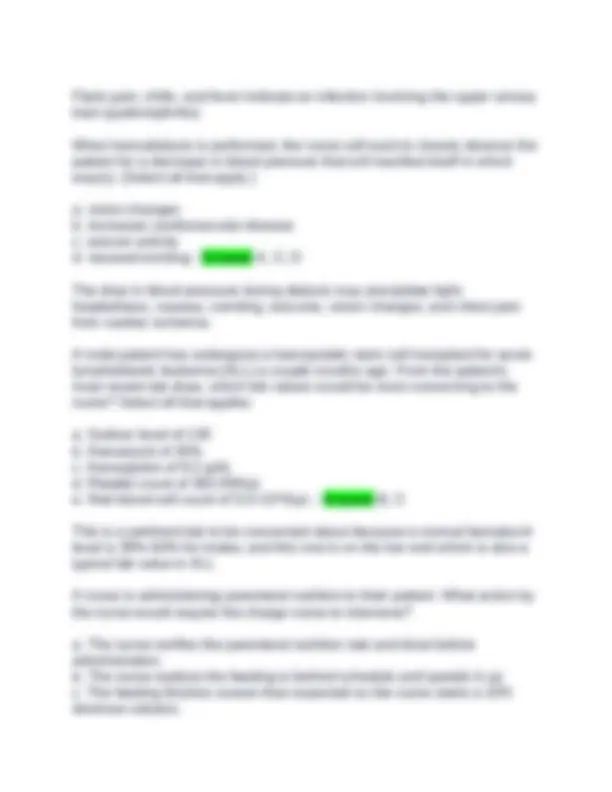
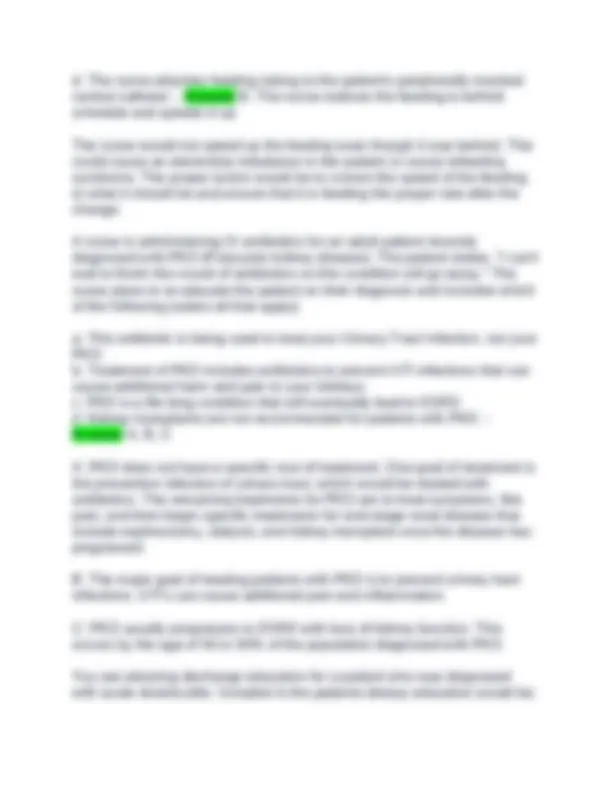
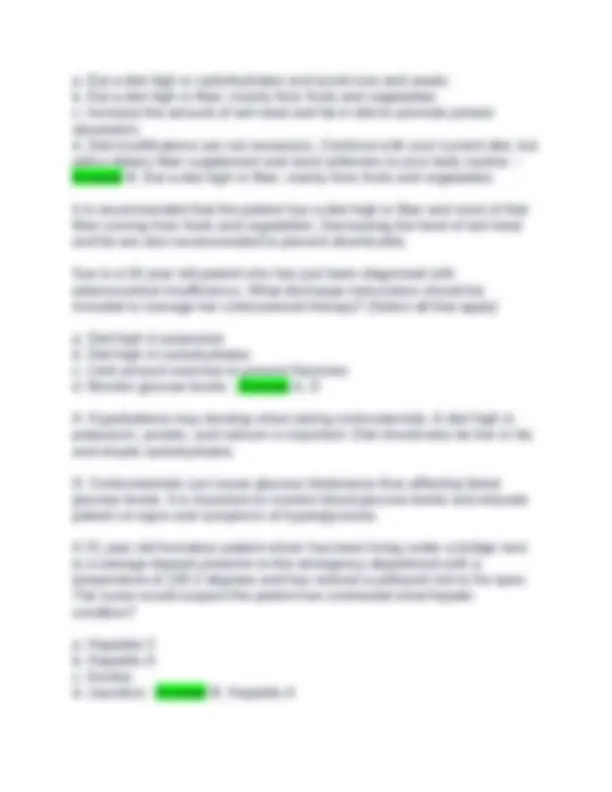
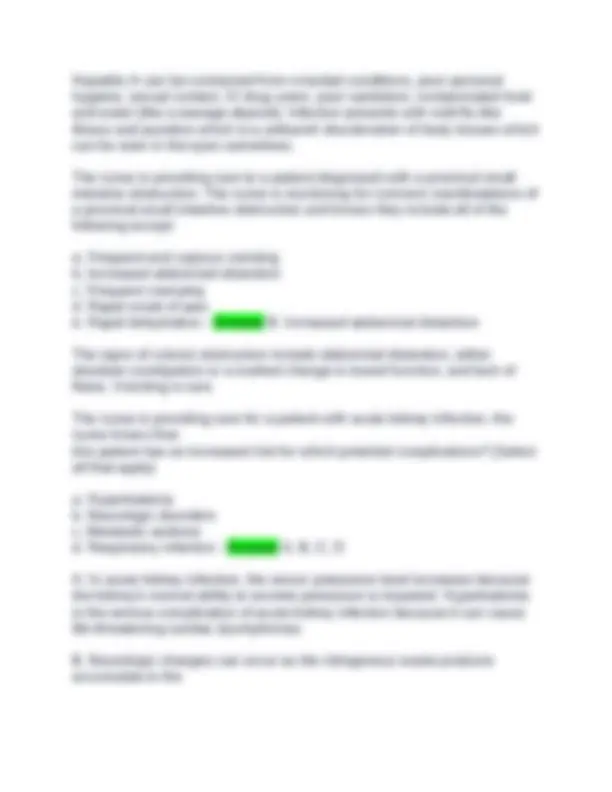
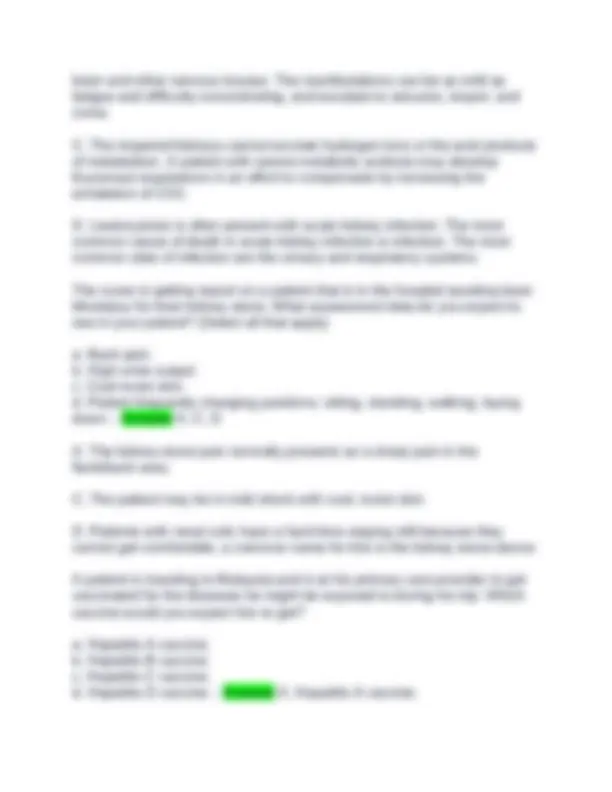
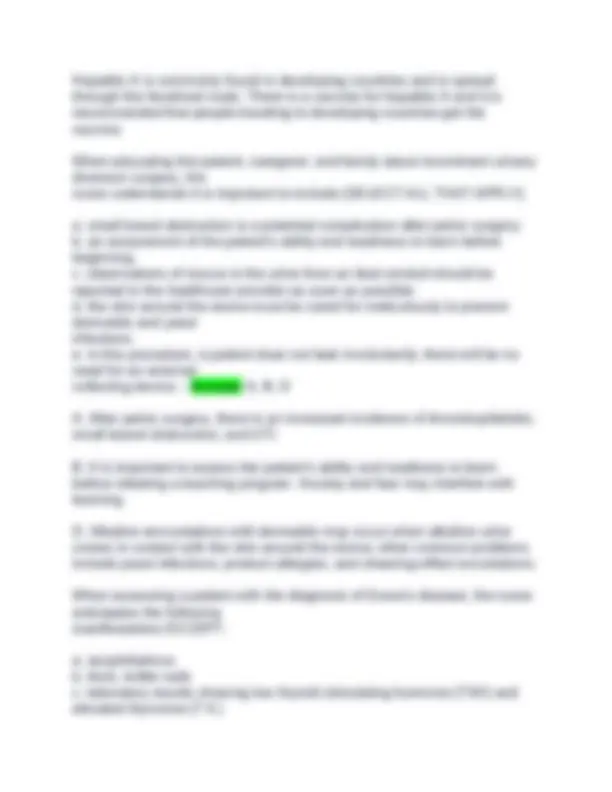
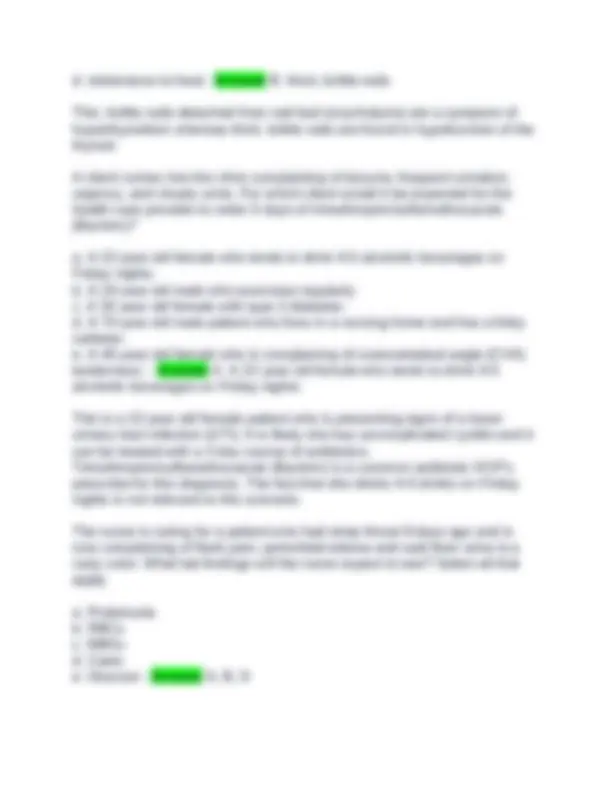
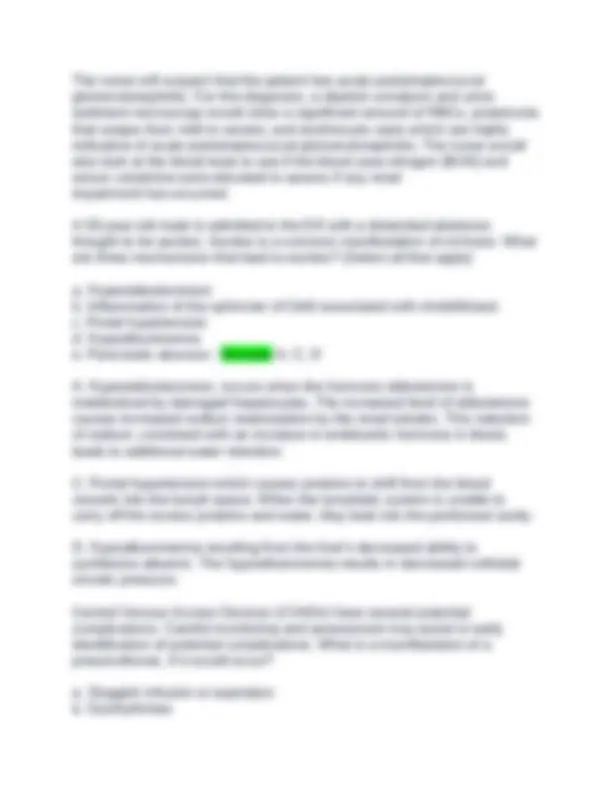
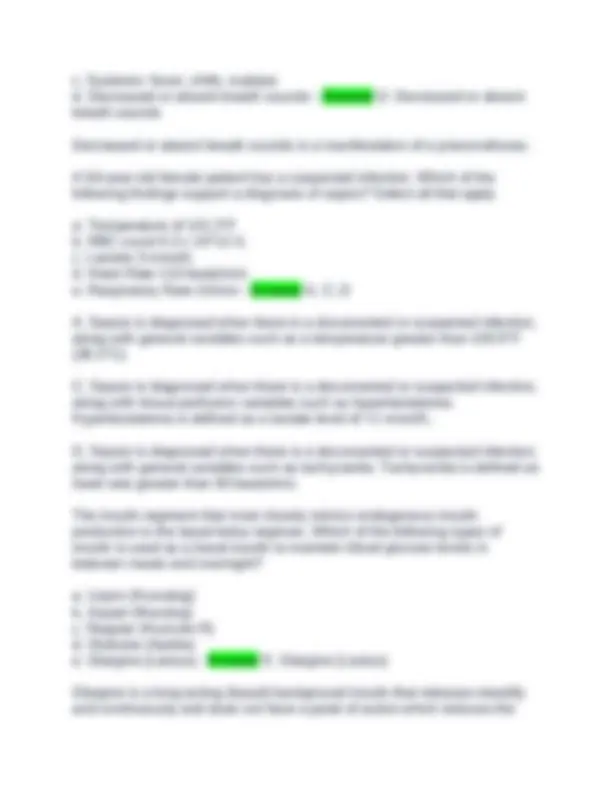
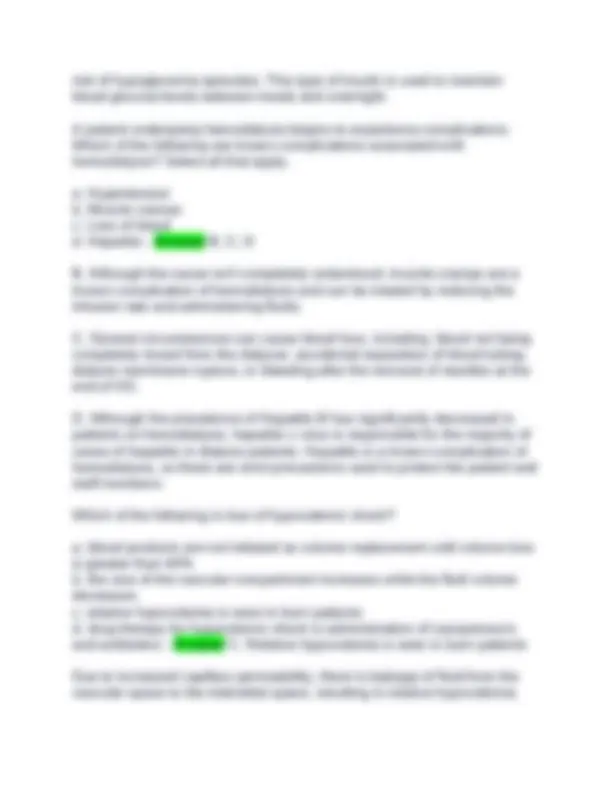
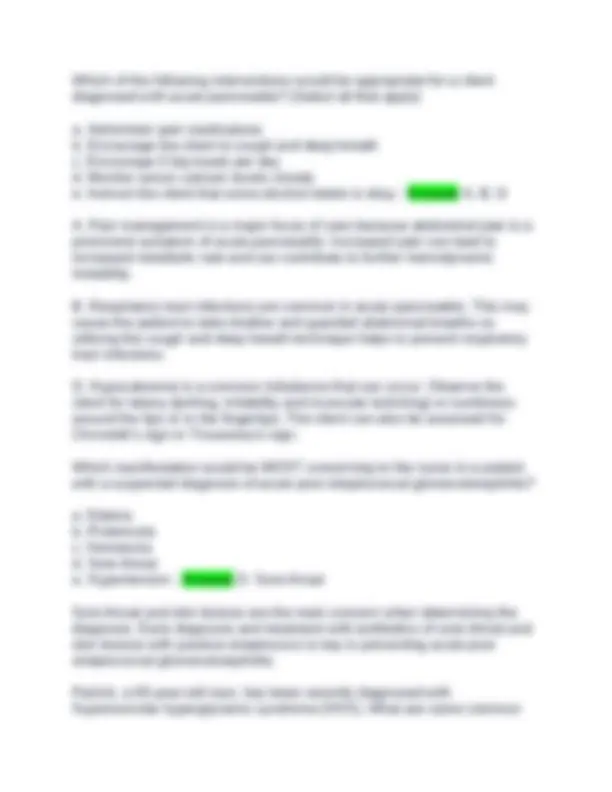
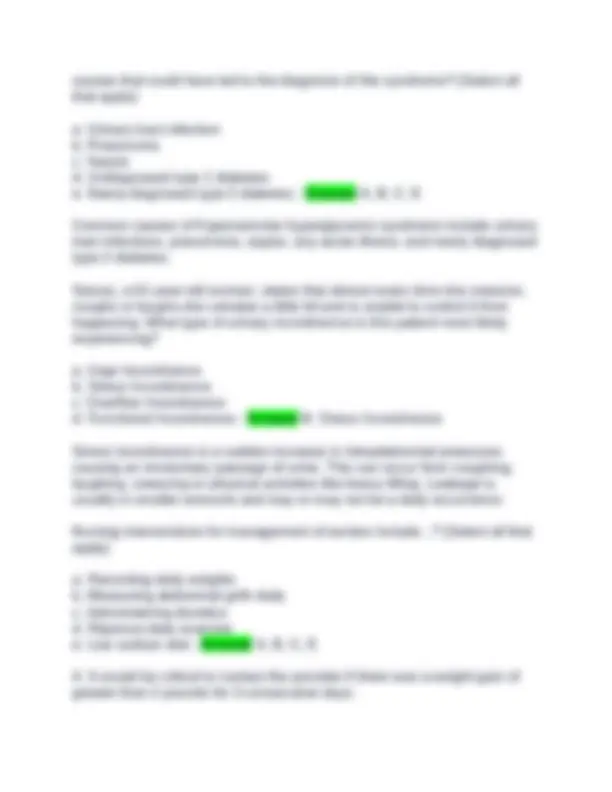
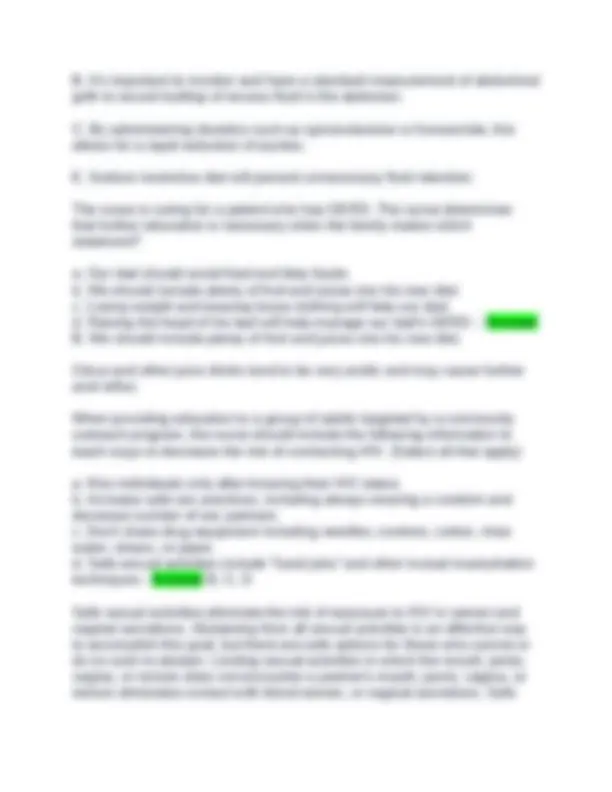
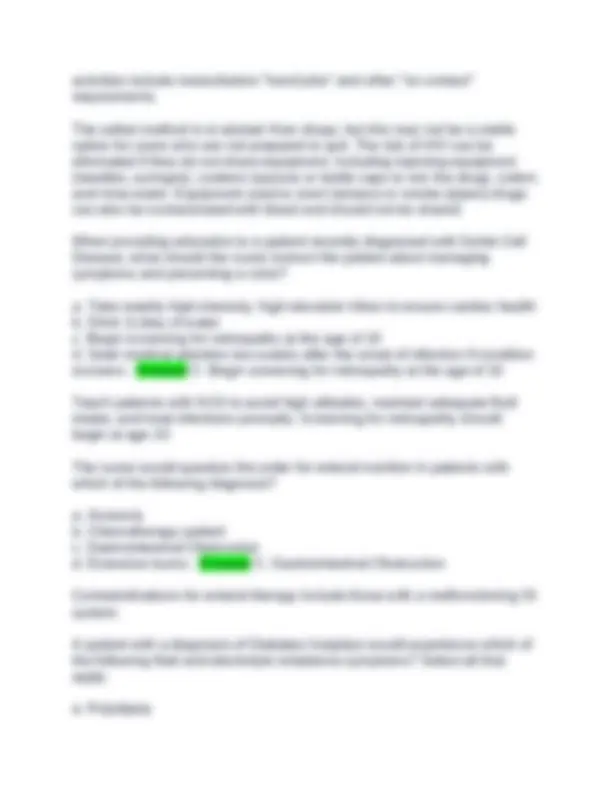
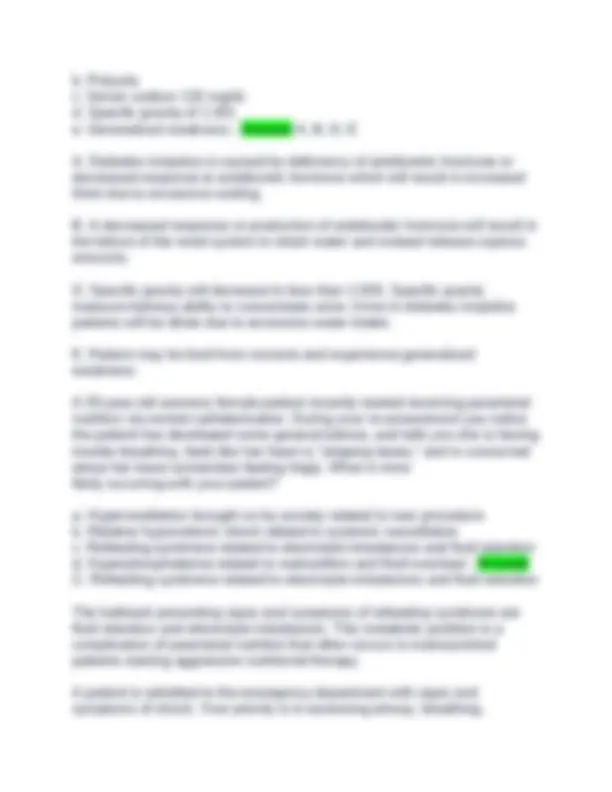
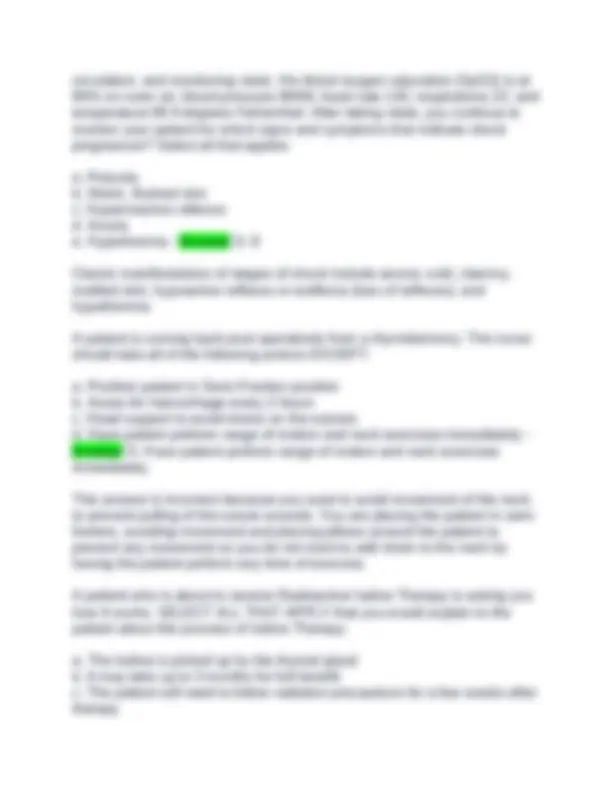
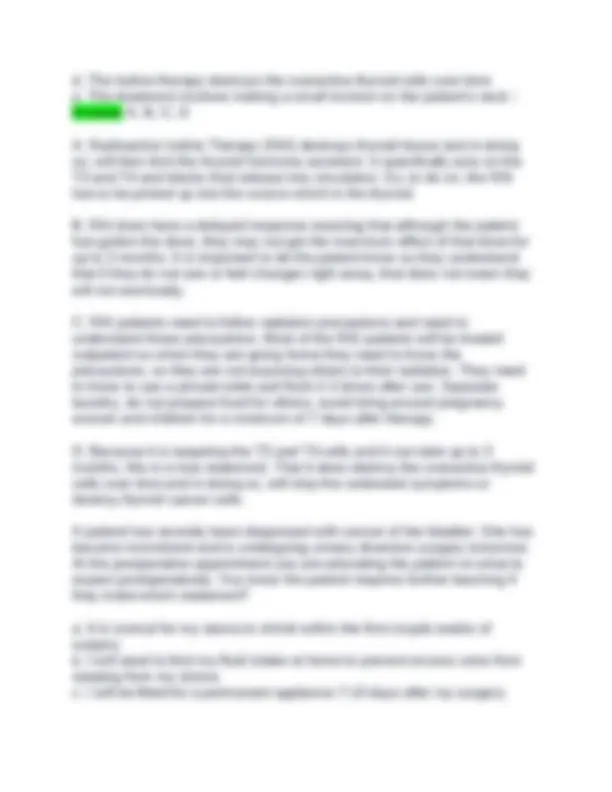
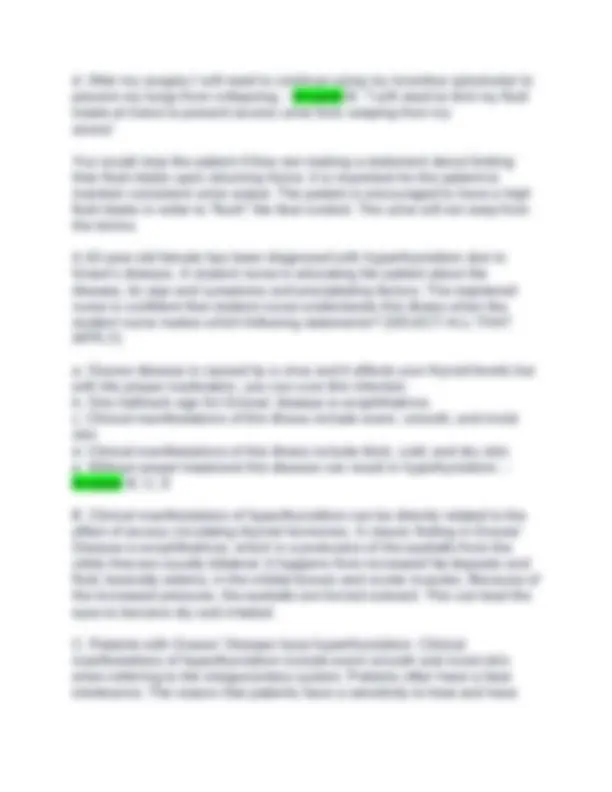
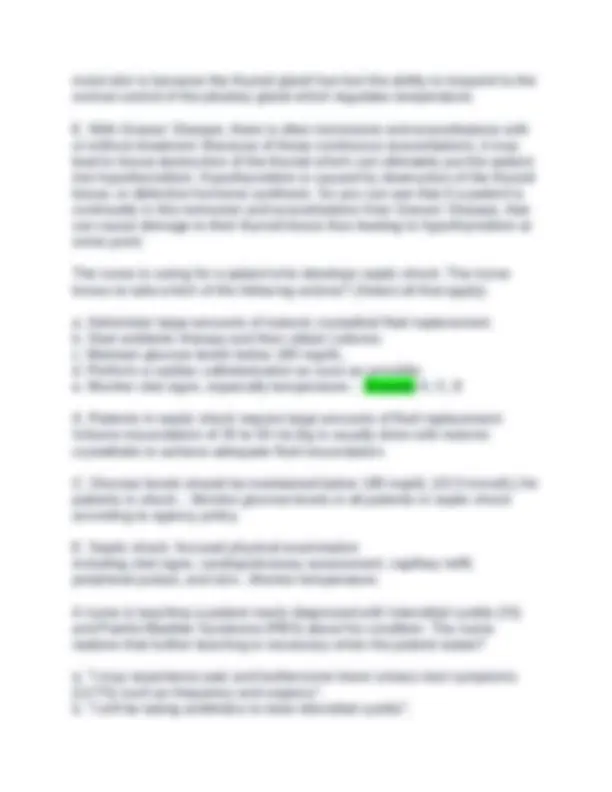
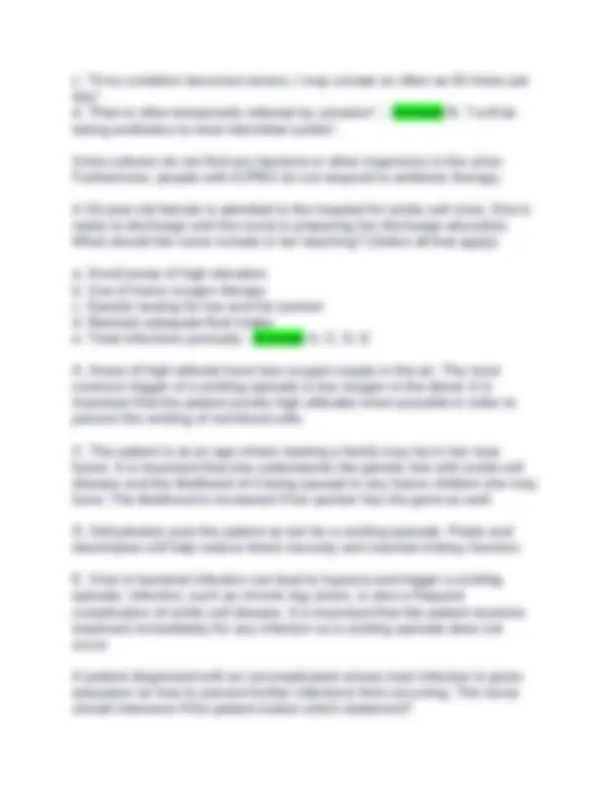
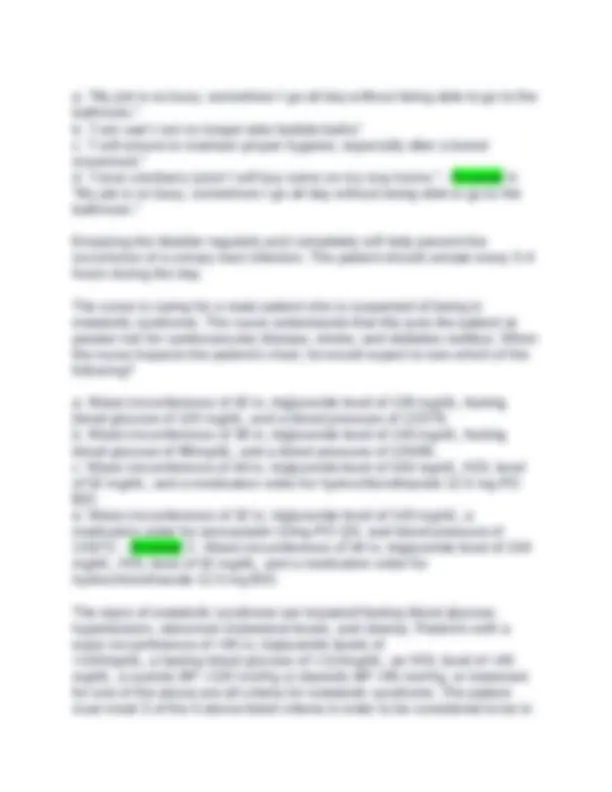
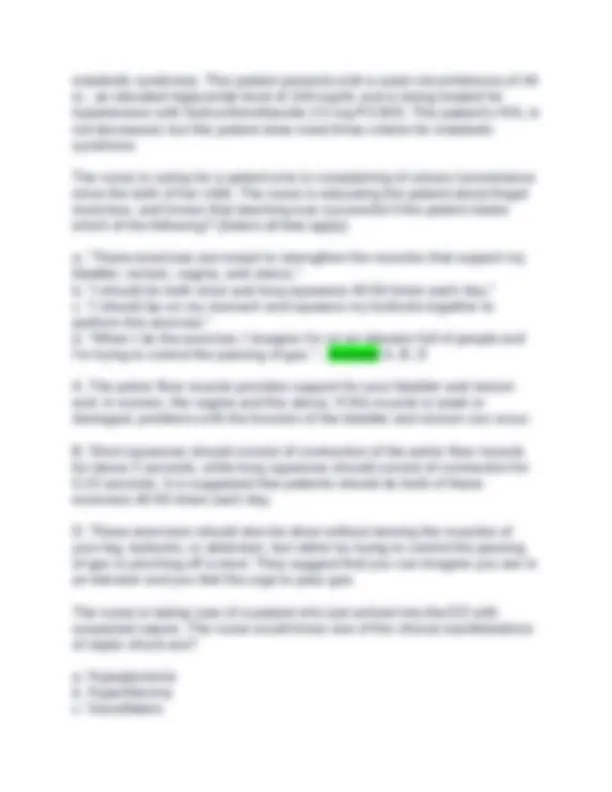
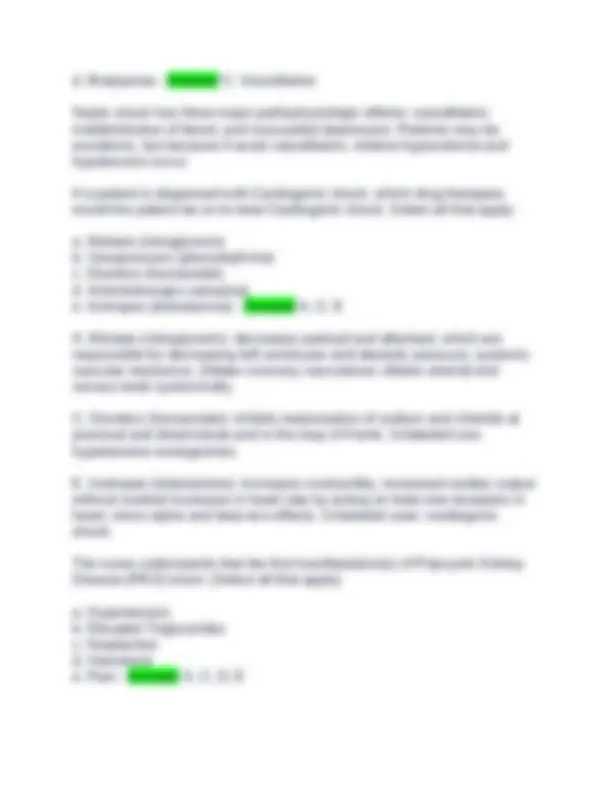
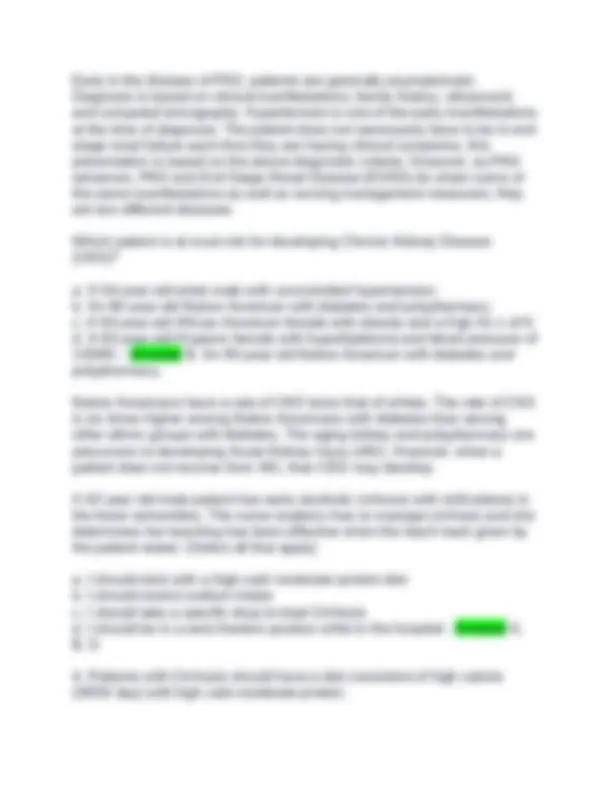
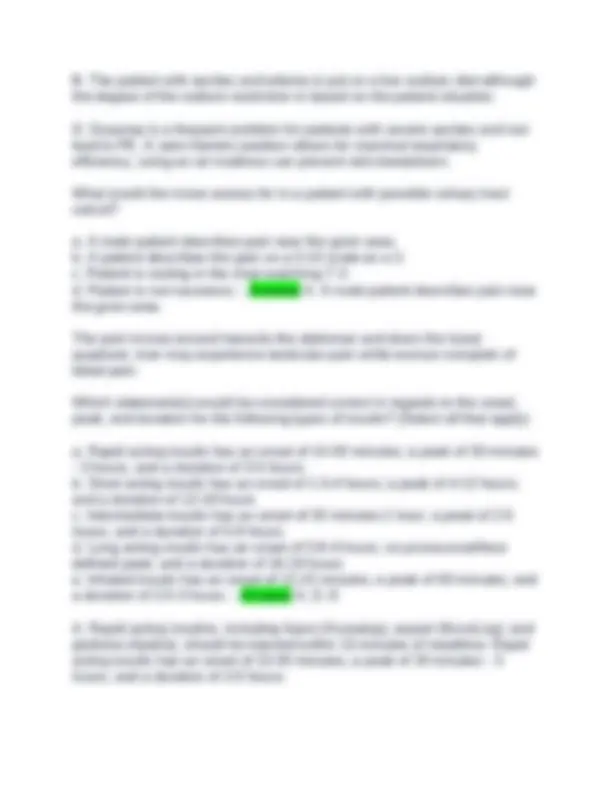
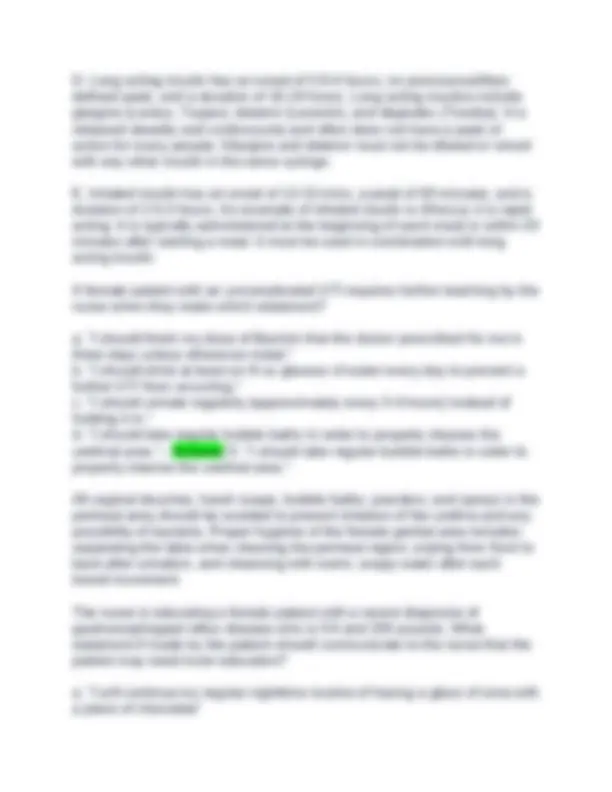
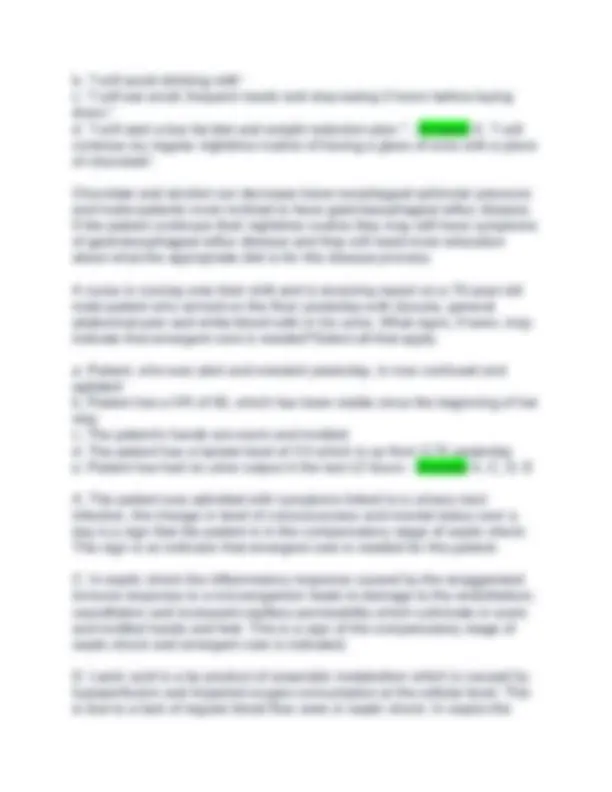
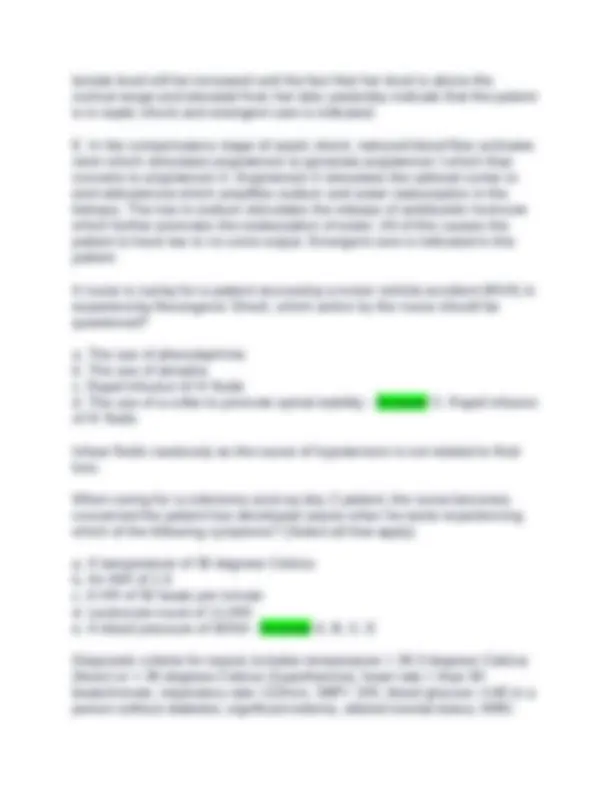
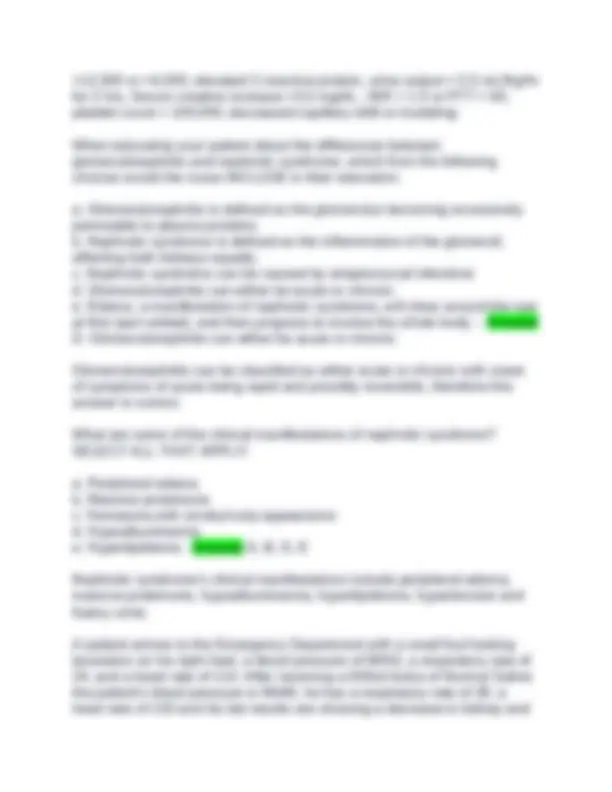
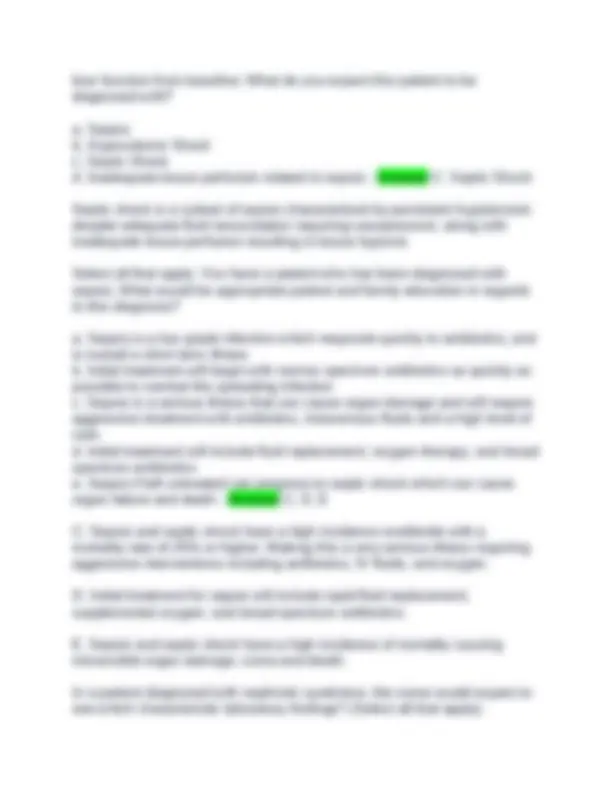
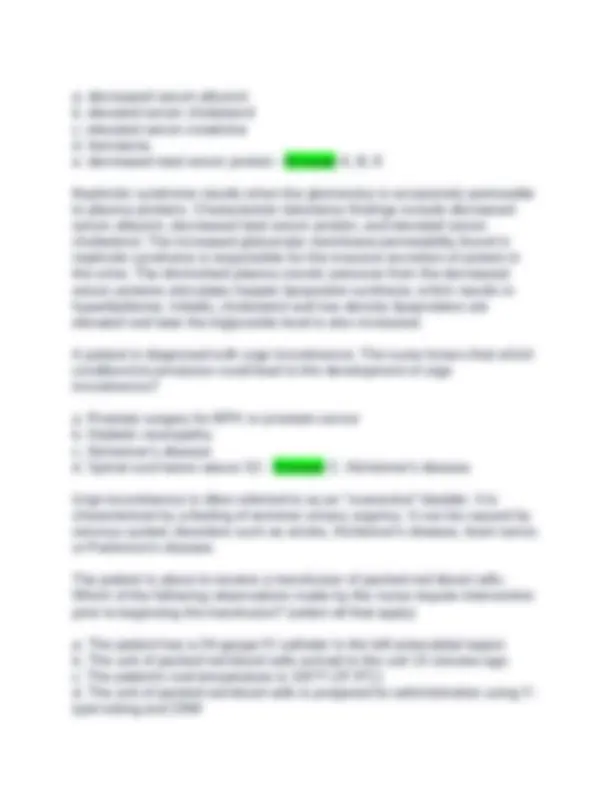
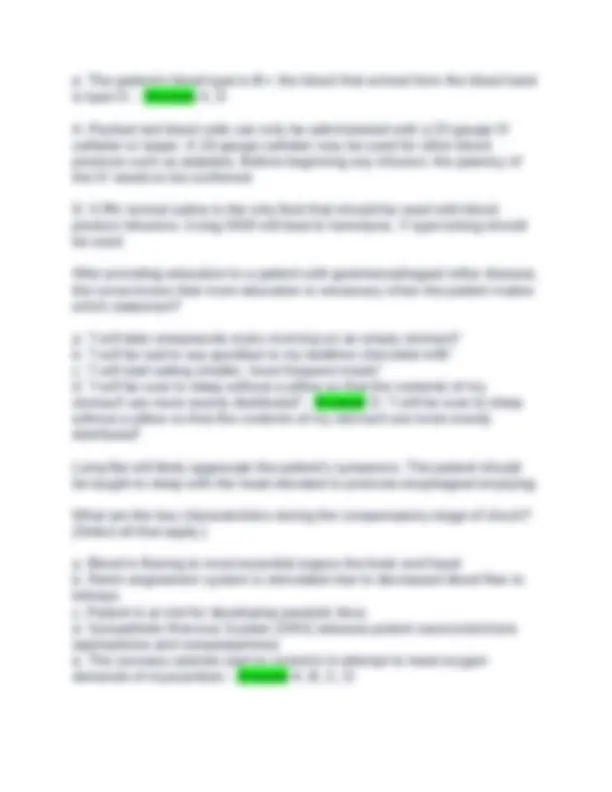
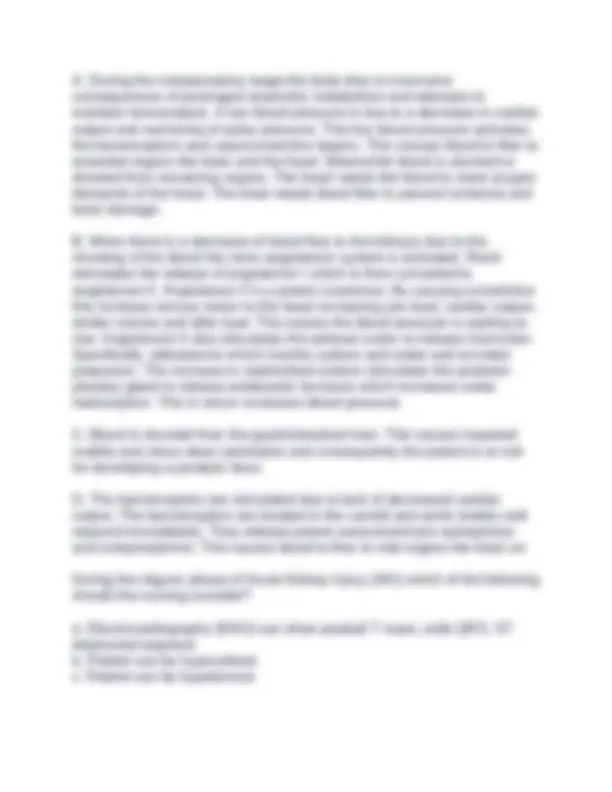
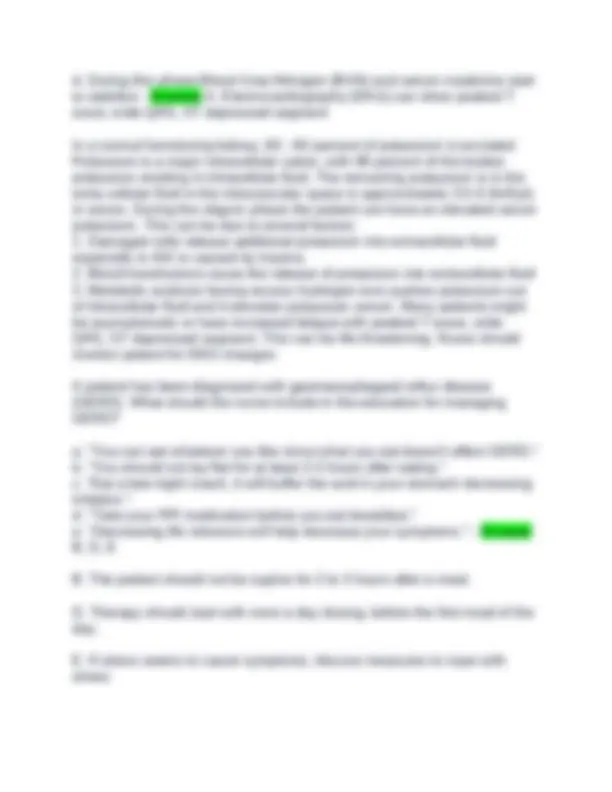
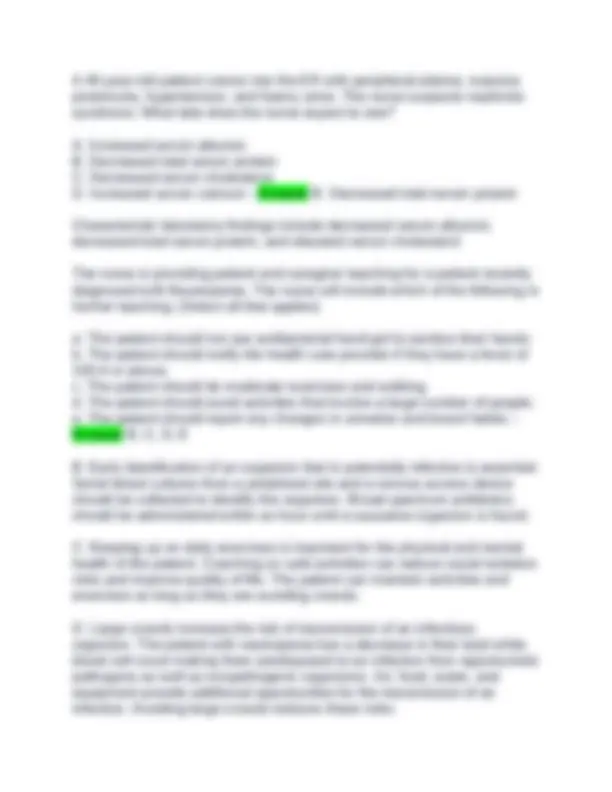
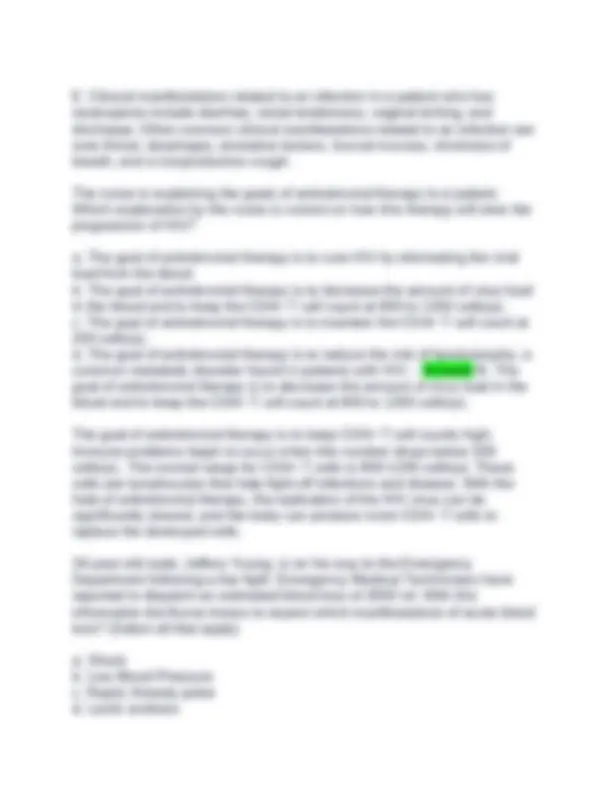
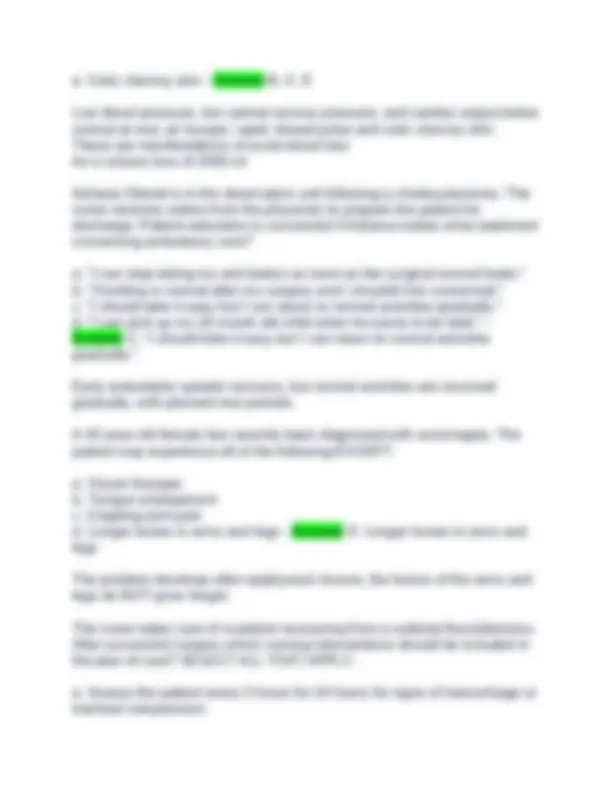
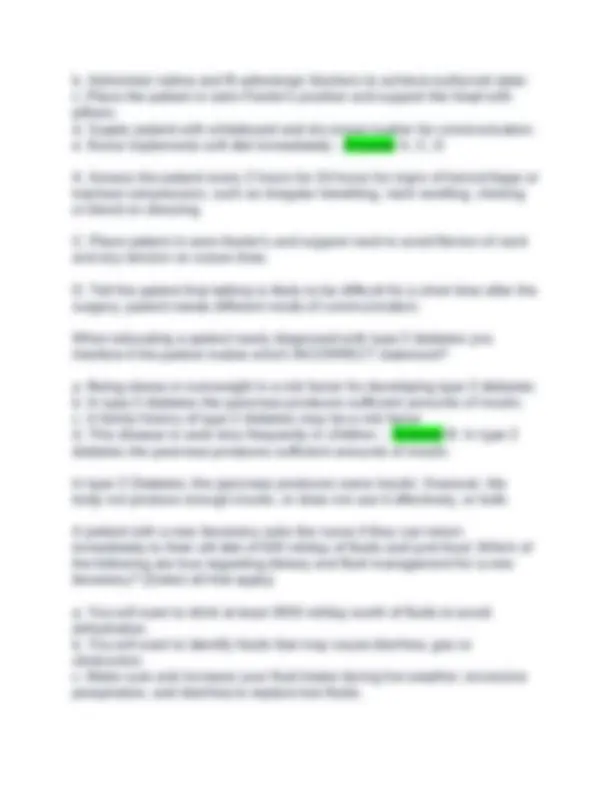
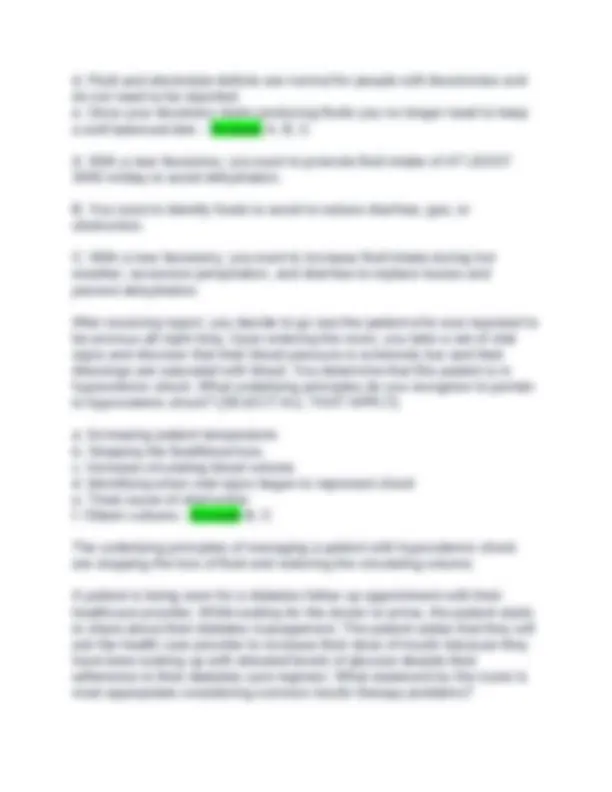
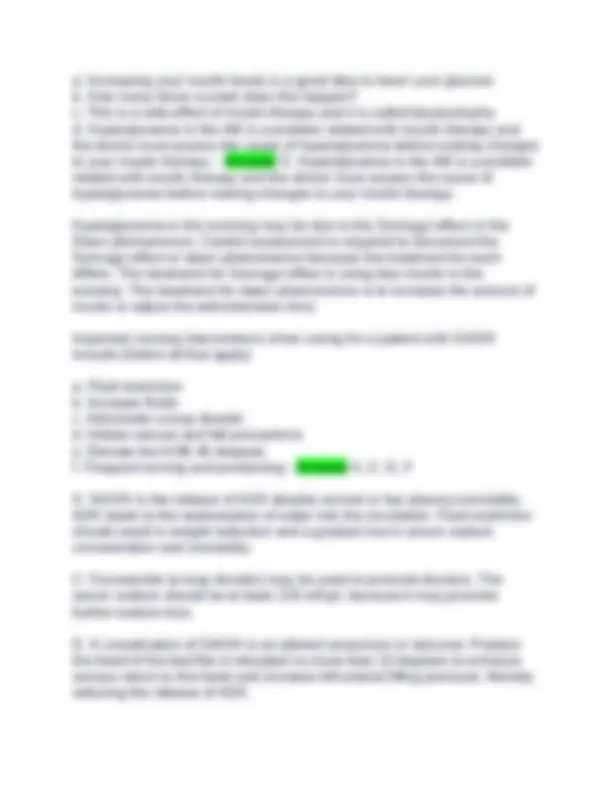
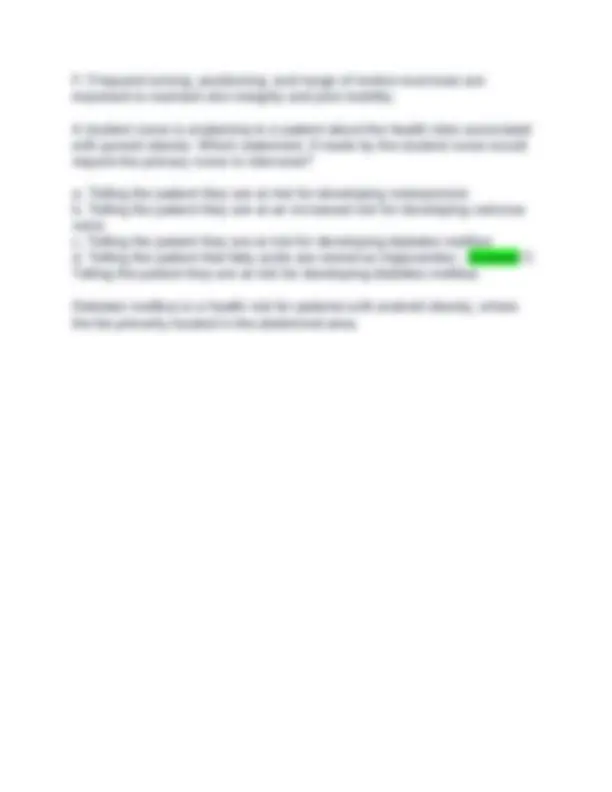


Study with the several resources on Docsity

Earn points by helping other students or get them with a premium plan


Prepare for your exams
Study with the several resources on Docsity

Earn points to download
Earn points by helping other students or get them with a premium plan
Community
Ask the community for help and clear up your study doubts
Discover the best universities in your country according to Docsity users
Free resources
Download our free guides on studying techniques, anxiety management strategies, and thesis advice from Docsity tutors
REVISED NCLEX QUESTIONS AND ANSWERS WITH RATIONALES 2024 UPDATED GRADED A+. REVISED NCLEX QUESTIONS AND ANSWERS WITH RATIONALES 2024 UPDATED GRADED A+.
Typology: Exams
1 / 58

This page cannot be seen from the preview
Don't miss anything!



















































A patient has been receiving chemotherapy and radiation for a diagnosis of non-Hodgkin's lymphoma. In your morning assessment, you notice the patient has new onset facial edema, distention of head and neck veins, and dyspnea. Which oncologic emergency would be suspected? a. Hypercalcemia b. Spinal Cord Compression c. Superior Vena Cava Syndrome (SVCS) d. Tumor Lysis Syndrome (TLS) - Answer C. Superior Vena Cava Syndrome (SVCS) The manifestations in the patient are all seen in SVCS in addition to headache, seizures, and often a mediastinal mass found on a chest x-ray. This complication is common with lung cancer, metastatic breast cancer, and non-Hodgkin's lymphoma When providing education to a patient newly diagnosed with cirrhosis, what information should be included? (select all that apply) a. Inform the patient that cirrhosis is an acute condition that can be alleviated with the correct drug regimen b. Avoid aspirin and NSAIDs to prevent hemorrhage c. Limit alcohol consumption to one drink per week d. Teach symptoms of complications and when to seek medical attention e. Avoid hepatotoxic over-the-counter (OTC) drugs - Answer B, D, E B. In patients with cirrhosis, especially if they have esophageal or gastric varices as a comorbidity, use of aspirin and NSAIDs is discouraged. The damage cirrhosis causes to the liver lowers its ability to assist in clotting and taking aspirin and NSAIDs, which also have anticoagulant properties, can increase the risk of hemorrhage
D. Patient should be informed of signs and symptoms to look for that may indicate worsening of their condition. These can include peripheral edema (swelling in extremities), signs of bleeding, ascites (build-up of fluid in peritoneal cavity), alterations in mental status, asterixis (flapping tremors), etc. If any of these symptoms occur, the patient should seek medical attention right away E. OTC drugs that may be toxic to the liver (ex: acetaminophen in high doses) should be avoided because the damage that cirrhosis causes to the liver makes it unable to metabolize those drugs A nurse is teaching a patient about prevention of a second UTI. Which of the statements made by the patient requires further intervention? a. "I will stop taking my antibiotic once the symptoms are gone." b. "I should consider drinking unsweetened cranberry juice in my diet." c. "I will urinate regularly approximately every 3-4 hours" d. "I will remember to drink fluids adequately." - Answer A. "I will stop taking my antibiotic once the symptoms are gone." It is important to take all antibiotics as prescribed. Symptoms may improve 1-2 days after therapy, but organisms maybe still present. A nursing student is teaching a patient about management of constipation. The nursing instructor would intervene if the student made which statement? (Select all that apply) a. The use of laxatives and enemas will help free up blockage. b. Eat foods with high fiber like raw vegetables and beans c. Drink about 3 quarts of fluid including coffee and energy drinks. d. Establish a regular time to defecate. e. Exercise about 3 times a week. - Answer A, C A. Do not overuse laxatives and enemas because they cause dependence. People who overuse them are unable to have a bowel movement without them. C. Fluid soften hard stools. Drink 2 L per day. Drink water or fruit juices. Avoid caffeinated coffee, tea, and cola. Caffeine stimulate fluid loss through urination.
A 43 year old woman is diagnosed with gastroesophageal reflux disease (GERD). What guidelines can the nurse provide to her for managing her symptoms? SELECT ALL THAT APPLY. a. Lie down after eating to relieve pressure b. Having peppermint or tea after eating can soothe any discomfort c. Avoid late night snacking d. Eating small, more frequent meals is better than eating a few large meals per day e. Drinking fluids between meals and not with meals can help prevent reflux
c. Encourage patient to get at least 60 min of direct sunlight per day d. Monitor platelet counts e. High fiber diet to prevent constipation - Answer A, B, D A. Direct renal damage from exposure to nephrotoxic agents such as cisplatin and high dose-methotrexate can be a complication from treatment. Therefore, labs for BUN and creatinine levels must be continuously monitored. B. Infection is a major cause of death in cancer patients because of low WBC's, especially neutrophils. It is recommended that because of immune suppression while undergoing treatment, it is best to avoid large crowds. D. Because spontaneous bleeding can occur with platelet counts <20,000, it is important that the nurse must monitor platelet counts. Lifestyle modifications are crucial for the management and prevention of gastroesophageal reflux disease (GERD). Which of the following is a strategy for good management to teach a patient who was recently diagnosed? a. Eat a small meal close to bedtime to ease the onset of GERD b. Avoid alcohol and caffeinated beverages c. Avoid taking sucralfate (Carafate) d. If a PPI is being taken, it is best to take it right before bedtime - Answer B. Avoid alcohol and caffeinated beverages Caffeinated beverages, as well as alcohol, cause an almost immediate, marked decrease in lower esophageal sphincter pressure. Because of this, alcohol and caffeinated beverages should be avoided. When providing education about diet for a patient who has had a history of gout and urinary calculi, the nurse should tell the patient to avoid or limit which of the following food selections (SELECT ALL THAT APPLY) a. Liver b. Corn c. Mussels d. Salmon e. Tomatoes - Answer A, C, D
C. Stopping hemodialysis would stop the influx of heparin from the machine. Heparin is used to prevent clotting in the machine. A student nurse is explaining the probable sites for an arteriovenous fistula to the patient. Which statement does the preceptor know suggests understanding of placement on the part of the student nurse? a. Brachial and antecubital area b. Cephalic or basilic vein with radial artery c. Femoral vein d. Internal jugular - Answer B. Cephalic or basilic vein with radial artery The brachial or basilic vein with the radial artery are used with an arteriovenous fistula The nurse is doing discharge teaching for a patient with a new diagnosis of thrombocytopenia. Which statement, if made by the patient, would indicate that the patient understands the teaching? (SELECT ALL THAT APPLY) a. "I can't wait to get back to my weights class at the gym!" b. "I will talk with my Dr. before my pedicure appointment next week." c. "I will stop taking my herbal supplements and over the counter medications until I speak with my Dr." d. "I will replace my toothbrush with one with medium bristles." e. "I will contact my Dr. if I get a headache, or my vision changes." - Answer B, C, E B. Talk with your HCP before you have any invasive procedures done, such as pedicures, manicures, or dental cleanings. C. Any medications or herbal supplements that prolong bleeding, such as aspirin, should be avoided. E. Headache and/or vision changes are a manifestation of bleeding. A patient's arterial blood gas (ABG) results are: PH; 7.31, PaCO2; 54 mmHg, HCO3; 25 mEq/L. What kind of acid-base imbalance is this? a. Metabolic acidosis, uncompensated b. Respiratory alkalosis, compensated
c. Respiratory acidosis, uncompensated d. Metabolic alkalosis, uncompensated e. Respiratory acidosis, compensated - Answer C.. Respiratory acidosis, uncompensated Respiratory acidosis occurs whenever the person hypoventilates. [This] leads to a buildup of CO2, resulting in an accumulation of carbonic acid in the blood. Renal compensatory mechanisms begin to operate within 24 hours. The kidneys conserve HCO3 (bicarbonate) and secrete increased concentrations of H+ (hydrogen) into the urine. Until the renal mechanisms have an effect, the serum HCO3 level will usually be normal, and then it will increase. A patient diagnosed with chronic kidney disease questions the nurse on his possibility of a kidney transplant. The nurse knows that which of the following factors would cause the patient to be unable to receive a kidney transplant (select all that apply): a. Unmanaged Bipolar II disorder b. Being over age 70 c. Having no familial relatives with a viable kidney to donate d. Disseminated lung cancer e. Being HIV positive f. Chronic respiratory failure - Answer A, D, F A. Contraindications to transplantation include disseminated malignancies, refractory or untreated cardiac disease, chronic respiratory failure, extensive vascular disease, chronic infection, and unresolved psychosocial disorders. D. Contraindications to transplantation include disseminated malignancies, refractory or untreated cardiac disease, chronic respiratory failure, extensive vascular disease, chronic infection, and unresolved psychosocial disorders. F. Contraindications to transplantation include disseminated malignancies, refractory or untreated cardiac disease, chronic respiratory failure, extensive vascular disease, chronic infection, and unresolved psychosocial disorders.
After a patient comes into the hospital for an AKI and you notice that he/she is experiencing severe dehydration, and oliguria. The patient does not encompass any damage to the kidney tissue but is experiencing decreased circulating blood volume, which stage of AKI would this patient be in? a. Acute tubular necrosis b. Intrarenal c. Prerenal d. Postrenal - Answer C. Prerenal The patient would be in the prerenal stage because this stage of an acute kidney injury has oliguria but does not have any damage to the kidney tissue and can be reversed with adequate treatment. The oliguria in this stage can be caused by severe dehydration, heart failure, and decreased cardiac output. A nurse is educating a female patient about to be discharged from the hospital after being treated for a urinary tract infection (UTI). The nurse recognizes the patient correctly understands the education material when they make the following statements, EXCEPT? (SELECT ALL THAT APPLY) a. I should urinate approximately every 3-4 hours throughout the day b. I should take bubble bathes as a way to get everything clean down there c. I should be emptying my bladder before and after sexual intercourse d. I should be wiping from front to back after urinating e. I should stop taking my antibiotics once the symptoms of my urinary tract infection (UTI) are gone - Answer B, E B. Avoid vaginal douches and harsh soaps, bubble baths, powders, and sprays in the perineal area. E. Emphasize the importance of taking the full course of antibiotics. Often patients stop antibiotic therapy once symptoms disappear. This can lead to inadequate treatment and recurrence of infection or bacterial resistance to antibiotics
A patient is presenting to the emergency department with confirmed anaphylactic shock after eating peanuts. Which order by the doctor would the nurse question in regard to the treatment of this patient? a. Epinephrine IM b. Albuterol c. Nitroglycerin d. Diphenhydramine - Answer C. Nitroglycerin Hypotension results from leakage of fluid out of the intravascular space into the interstitial space as a result of increased vascular permeability and vasodilation. Vasodilators, such as nitroglycerin, would be contraindicated Which statement(s) is/are correct about Acute Kidney Injury (AKI)? Select all that apply. a. The most common intrarenal cause is acute tubular necrosis. b. The onset is gradual and often over many years. c. Prerenal and postrenal AKI usually resolves quickly with treatment. d. The RIFLE classification is used to describe the stages of AKI. e. Diagnostic criteria of AKI are acute reduction in urine output and /or elevation in serum creatinine. - Answer A, C, D, E A. Acute tubular necrosis (ATN) is the most common intrarenal cause of AKI and is primarily the result of ischemia, nephrotoxins, or sepsis. C. Prerenal and postrenal AKI that has not caused intrarenal damage usually resolves quickly with treatment. When parenchymal damage occurs due to either prerenal or postrenal causes, or when parenchymal damage occurs directly as with intrarenal causes, AKI has a prolonged course. D. The RIFLE classification is used to describe the stages of AKI. Risk, Injury, Failure, Loss, and End-stage renal disease. E. Although changes in urine output and serum creatinine occur relatively late in the course of AKI, they are known diagnostic indicators. The rate of increase in serum creatinine is also important as a diagnostic indicator in determining the severity of injury. What is Inflammatory bowel disease (IBD)?
c. My A1C goal is less than 7% d. I will only require a once daily injection of Lantus e. I will carry cookies with me in case my blood glucose drops below 70 - Answer A, C A. Type 1 Diabetes Mellitus is an autoimmune disorder in which the body develops antibodies against insulin or the beta pancreatic cells. This results in an 80-90% reduction in islet cells. The person can no longer produce enough insulin to survive. C. A goal of an A1C <7% is the recommended guideline from the ADA. This level decreases the risk for micro and macrovascular damage. A student nurse is providing health promotion activities to a patient and caregiver to prevent the recurrence of a Urinary Tract Infection. Which statement by the student would require correction from the nurse? a. When providing appropriate hygiene wipe from back to front after urinating b. Maintain adequate fluid intake c. Report to the HCP symptoms or signs of recurrent UTI d. Consider drinking unsweetened cranberry juice or taking cranberry extract tablets 300-400 mg/day - Answer A. When providing appropriate hygiene wipe from back to front after urinating Health promotion activities can help decrease the frequency of infections and provide early detection of infection. Health promotion activities include teaching preventative measures such as 1) emptying the bladder regularly and completely, 2) evacuating the bowel regularly, 3) wiping the perineal area from front to back after urination and defecation, and 4) drinking an adequate amount of liquid each day. What clinical manifestations would you expect to find in a patient diagnosed with Irritable Bowel Disease presenting with hypomagnesemia? (Select all that apply) a. Trousseau's sign b. Diminished deep tendon reflexes c. Vertigo d. Muscle cramps
e. Urinary retention f. Confusion - Answer A, C, D, F Clinically, hypomagnesemia resembles hypocalcemia. Neuromuscular manifestations are common such as muscle cramps, tremors, hyperactive deep tendon reflexes, Chvostek's sign, and Trousseau's sign. Neurologic manifestations include confusion, vertigo, and seizures. A patient's morning lab has hemoglobin level of 5 g/dL, the integumentary changes. The nurse will notice in this patient include the following? (Select all that apply). a. Pallor b. Jaundice c. Anorexia d. Pruritus e. Increased pulse pressure - Answer A, B, D The clinical manifestations of anemia are caused by the body's response to tissue hypoxia. Specific manifestations vary depending on the rate at which the anemia has evolved, its severity, and any coexisting disease. Hemoglobin levels are often used to determine the severity of anemia. The integumentary changes include pallor, jaundice, and pruritus, and in addition to the skin, the sclera of the eyes and mucous membrane are evaluated for jaundice because they reflect the integumentary changes more accurately A critically ill patient is diagnosed with severe hypokalemia. Appropriate treatment modalities for the management of severe hypokalemia include (select all that apply) a. Set up continuous electrocardiogram monitoring b. Administer a bolus of intravenous potassium chloride c. Frequently assess the intravenous site for phlebitis and infiltration d. Monitor urine output - Answer A, C, D A. Patients who are critically ill should have continuous electrocardiogram monitoring to detect cardiac changes.
AKI as prerenal, intrarenal, and postrenal. Which of the following are potential causes of prerenal AKI? Select all that apply. a. Severe dehydration b. Heart failure c. Damage to kidney tissue d. Decreased cardiac output e. Nephrotoxins - Answer A, B, D A. Severe dehydration decreases systemic circulation. The decreased systemic circulation causes a reduction in renal blood flow. The decrease in blood flow leads to decreased glomerular perfusion and filtration of the kidneys. B. Heart failure decreases systemic circulation because the heart is not able to pump effectively. In turn, this failure of the heart to pump is causing circulation issues. The decrease in blood flow leads to decreased glomerular perfusion and filtration of the kidneys. D. Normal adults have cardiac output of 4.7 liters a minute. When CO falls below this amount, there is decreased circulation. The decreased circulation to the kidneys decreases glomerular perfusion and filtration of the kidney. A patient is diagnosed with Grave's disease. They are scheduled to have a complete thyroidectomy. What post-op complication should the nurse educate the patient on that involves an excessive amount of thyroid hormone being released into circulation and is considered a medical emergency if left untreated? a. Thyroid Storm b. Exophthalmos c. Goiter d. Hyperthyroidism e. Decreased basal metabolic rate - Answer A. Thyroid Storm Thyroid storm also known as thyrotoxic crisis is an acute, severe, and rare condition that occurs when excessive amounts of thyroid hormones are released into circulation. This is a life-threatening emergency if left untreated. Thyroid storm happens as a result of manipulation of the
hyperactive thyroid gland which causes an increase in hormones released all at once. After providing education to a patient with Chronic Kidney Disease (CKD) receiving bi-weekly Peritoneal Dialysis, which of the following statements indicates that dietary coaching has been effective? a. "I can drink as much water as I want as long as my weight and blood pressure are controlled." b. "My daily protein intake should be 2.1 g/kg of my ideal body weight." c. "My nutritional energy sources should come primarily from carbohydrate and fat sources." d. "I will not require supplements to balance my nutritional needs if I'm receiving erythropoietin." - Answer A. "I can drink as much water as I want as long as my weight and blood pressure are controlled." Patients undergoing Peritoneal Dialysis have an unrestricted fluid allowance if weight and blood pressure are controlled. Which of the following are risk factors for developing Chronic Kidney Disease? (Select all that apply) a. Diabetes Mellitus b. Hypertension c. Minority population status d. Burns - Answer A, B, C Chronic kidney disease has a high in minority populations, especially African Americans and Native Americans. Although Chronic kidney disease has many different causes, the leading causes are diabetes (about 50%) and hypertension (about 25%). A patient asks the student nurse to explain common symptoms of a lower urinary tract infection. The student nurse would be correct if they gave all the symptoms except which of the following? a. Dysuria b. Suprapubic discomfort c. Flank pain d. Urgency - Answer C. Flank pain
d. The nurse attaches feeding tubing to the patient's peripherally inserted central catheter. - Answer B. The nurse realizes the feeding is behind schedule and speeds it up. The nurse would not speed up the feeding even though it was behind. This could cause an electrolyte imbalance in the patient or cause refeeding syndrome. The proper action would be to correct the speed of the feeding to what it should be and ensure that it is feeding the proper rate after the change. A nurse is administering IV antibiotics for an adult patient recently diagnosed with PKD (Polycystic kidney disease). The patient states, "I can't wait to finish this round of antibiotics so this condition will go away." The nurse plans to re-educate the patient on their diagnosis and includes which of the following (select all that apply): a. This antibiotic is being used to treat your Urinary Tract Infection, not your PKD. b. Treatment of PKD includes antibiotics to prevent UTI infections that can cause additional harm and pain to your kidneys. c. PKD is a life-long condition that will eventually lead to ESRD. d. Kidney transplants are not recommended for patients with PKD. - Answer A, B, C A. PKD does not have a specific rout of treatment. One goal of treatment is the prevention infection of urinary tract, which would be treated with antibiotics. The remaining treatments for PKD are to treat symptoms, like pain, and then begin specific treatments for end-stage renal disease that include nephrectomy, dialysis, and kidney transplant once the disease has progressed. B. The major goal of treating patients with PKD is to prevent urinary tract infections. UTI's can cause additional pain and inflammation. C. PKD usually progresses to ESRD with loss of kidney function. This occurs by the age of 60 in 50% of the population diagnosed with PKD. You are planning discharge education for a patient who was diagnosed with acute diverticulitis. Included in the patients dietary education would be:
a. Eat a diet high in carbohydrates and avoid nuts and seeds. b. Eat a diet high in fiber, mainly from fruits and vegetables. c. Increase the amount of red meat and fat in diet to promote protein absorption. d. Diet modifications are not necessary. Continue with your current diet, but add a dietary fiber supplement and stool softeners to your daily routine. - Answer B. Eat a diet high in fiber, mainly from fruits and vegetables. It is recommended that the patient has a diet high in fiber and most of that fiber coming from fruits and vegetables. Decreasing the level of red meat and fat are also recommended to prevent diverticulitis. Sue is a 34 year old patient who has just been diagnosed with adrenocortical insufficiency. What discharge instructions should be included to manage her corticosteroid therapy? (Select all that apply) a. Diet high in potassium b. Diet high in carbohydrates c. Limit amount exercise to prevent fractures. d. Monitor glucose levels - Answer A, D A. Hypokalemia may develop when taking corticosteroids. A diet high in potassium, protein, and calcium is important. Diet should also be low in fat, and simple carbohydrates. D. Corticosteroids can cause glucose intolerance thus affecting blood glucose levels. It is important to monitor blood glucose levels and educate patient on signs and symptoms of hyperglycemia. A 31 year old homeless patient whom has been living under a bridge next to a sewage deposit presents to the emergency department with a temperature of 100.2 degrees and has noticed a yellowish tint to his eyes. The nurse would suspect the patient has contracted what hepatic condition? a. Hepatitis C b. Hepatitis A c. Ascites d. Jaundice - Answer B. Hepatitis A